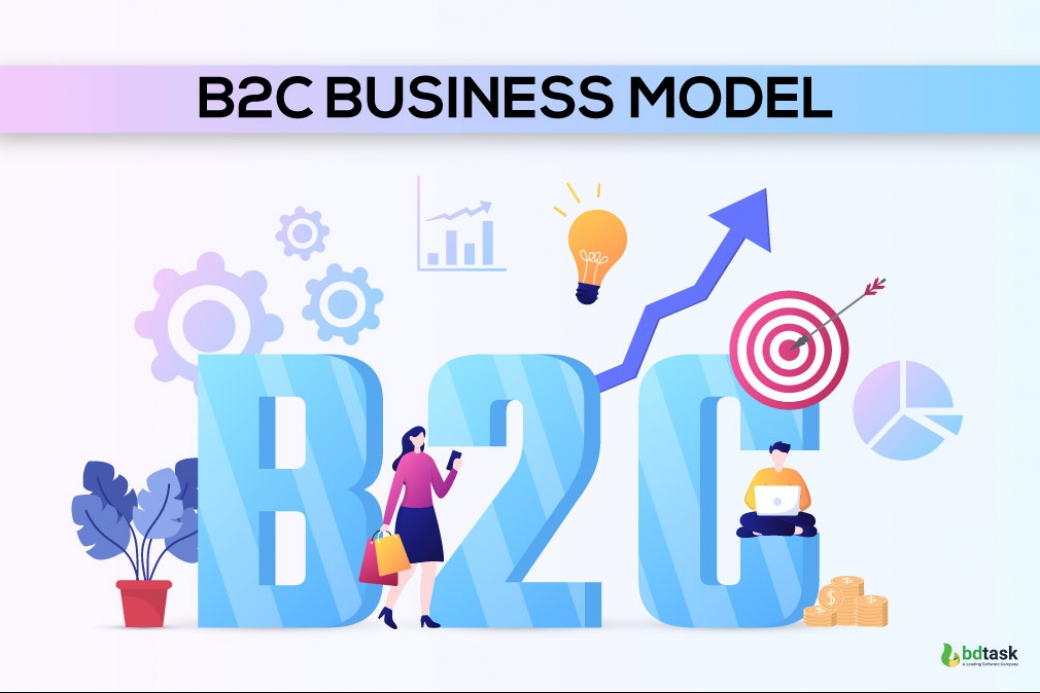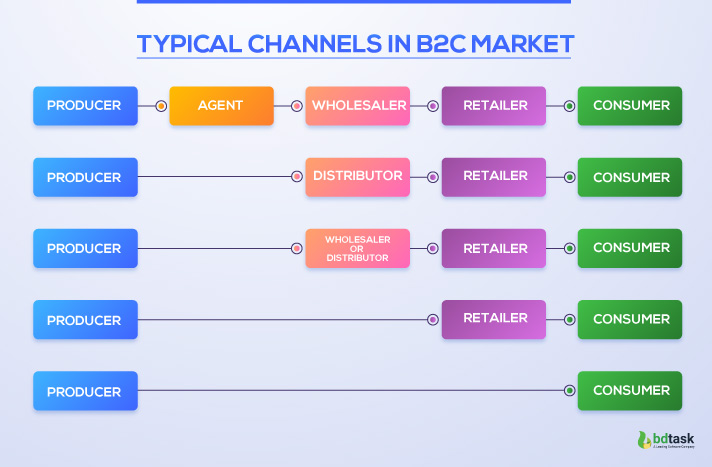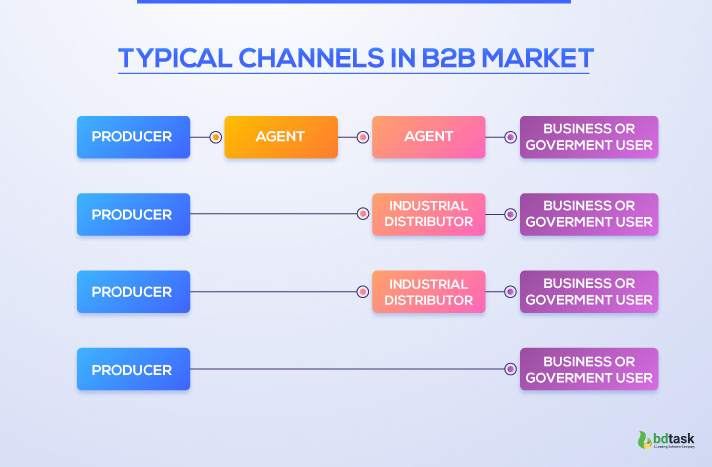Examples of B2C Business Model - (Business-to-Customer Based Firm)

Business-to-business (B2B) refers to business transactions, whereas business-to-consumer (B2C) refers to selling goods or services to individuals. This article will give you a complete idea of B2C business models with types, benefits, and examples of successful B2C businesses.
In the late 1990s, online retailers sold products or services to consumers through the Internet. It got immensely popular at that time as a B2C business. Nowadays, online B2C business is the most promising and fastest-growing business sector.
According to the Statista report, global retail e-commerce sales were estimated at around 4.9 trillion dollars in 2021. Over the next four years, this value is expected to increase by 50%, reaching $7.4 trillion by 2025.
B2C online business is also known as B2C eCommerce. Business-to-consumer enterprises, often B2C firms, use the Internet to connect, interact, and transact business with customers directly.
B2C comprises online banking, online auctions, and health and real estate websites, travel services, among other things.
However, smaller businesses benefit from B2C because individual customers are less interested in brand recognition and more focused on getting the best deal.
What Is Business to Customer(B2C)?
A B2C business model is one in which a company offers a service or product directly to a customer. Amazon, eBay, Walmart, and other B2C enterprises are well-known examples of companies where individual consumers are the end-users of a product or service.
The business-to-consumer model is an alternative to the business-to-business (B2B) model. B2C is a business strategy that often comprises a larger number of clients but has lower revenue per client and shorter sales cycles.
In a word, the B2C business model is the process of selling services or products directly to customers without any middleman. This type of business is conducted between the business owners and the customers, who are the end-users of the products or services.
How Does B2C Work?
In many industries and countries, many businesses operate using the business-to-consumer (B2C) model. b2c business model examples
that use the B2C business model are restaurants, cinemas, shopping malls, and others.
Some businesses use the B2C model via the Internet, selling their goods and services to their customers through e-commerce. It is important to state that B2C companies have a good customer relations management model. It will help them maintain good relationships with their customers and, in the end, drive sales growth and profit margin.
What Are The Types Of B2C Business Models?
B2C business is different in types based on the implementation. Successful B2C business owners follow the five types of B2C business models.
Every type of B2C model is comparable to another type. Although most businesses model follows more than one type of B2C model to reach the target audience, you can utilize one or more to fulfill your business goals.
1. Direct Sellers
One of the most common B2C types is the direct sellers or online retailers, who sell a product to customers directly to the customers through a website. It covers both small online enterprises and large shops.
Direct sellers can be divided into two categories
- manufacturers and
- E-tailers.
Product manufacturers use online sales channels to sell their products without any middlemen.
And E-tailers refer to electronic retailers who ship products from their warehouses.
For example, Zara, Microsoft, and Apple offer only their items on their website or online shop that are direct sellers.
In addition, Amazon, Walmart, and Costco sell other brands' products or services. They are also considered direct sellers.
2. Online Intermediaries
Online intermediates are go-betweens who connect businesses and potential clients through their websites. Online intermediaries do not own any goods, services, or brands, and their sole purpose is to connect people who want to buy and those who want to sell.
For example, Expedia, trivago, and Etsy allow individuals and small businesses to sell their artistic items and services under their unique brands on their specific websites. Customers can then go to the website and buy straight from the vendors.
3. Advertisement-Based B2C Models
E-commerce sites that rely on advertisements do not own any products or services. They sell advertisements for products and services that other companies own.
This type of B2C model is getting popular because the number of online media consumers is increasing greatly.
Free content is used in this strategy to attract visitors to a website. Following that, these visitors are exposed to digital or online adverts. Advertising, which sells goods and services, uses large web visitors.
As these websites gain popularity, they become known as influential websites promoting other businesses.
For instance, Huffington Publish and The Guardian are two of these eCommerce strategies, in which both sites post advertisements for items and services offered by other companies.
4. Community-Based B2C Models
Businesses target online forums connected to their products and services in the community-based e-commerce model and market their items there.
Marketers and advertisers can push their products directly to consumers through different social media platforms, which create online communities based on similar interests. Ads are often targeted depending on demographics and the geographic location of viewers on websites.
For example, Meta has groups and communities based on certain interests, allowing businesses to locate the right one to market their services to.
5. Fee-Based
The paid subscription services or the pay-as-you-go are included in the fee-based B2C based model. Customers are charged to use fee-based eCommerce sites since their products or services can be accessed directly there.
For example,
subscription-based entertainment services such as Netflix, Amazon Prime, and Hulu, and sites that provide articles and stories, such as Medium.
However, the B2C business model types apply to almost all online businesses. Implement any type of B2C model and get the desired customers to ensure your revenue.
B2C Vs B2B: Differences with Examples
Businesses are generally price-sensitive and unconcerned about the presentation, whereas consumers are less price-sensitive and more concerned with presentation.
When it comes to selling chocolate to businesses, the container or package in which it arrives is unimportant. However, packaging is a major selling feature when selling to a consumer.
In addition, generally, B2B business models have more revenue per customer but lower volume. On the other hand, B2C business models have a larger volume but lower revenue.
For instance, Microsoft is typically considered a B2C company, although their cloud hosting service, Azure, is a B2B offering.
As previously stated, the business-to-consumer (B2C) model differs from the business-to-business (B2B) approach.
Consumers buy things for personal consumption in the B2C model, while businesses buy products for their companies in the B2B business.
The B2B business model has a variety of pricing structures. Regarding B2C, consumers frequently pay the same amount for the same items.
Prices are not always comparable. Businesses frequently negotiate prices and payment arrangements.
Typical Channels in B2C Market

Typical Channels in B2B Market

B2C Companies Examples
As B2C companies continue to grow in popularity, there will invariably be successful businesses that have come from it. So far, most examples of b2c include:
- Amazon
- Tencent
- Walmart
- Target
- Alibaba
- Priceline Group
- eBay
- Netflix etc.
Many online retailers selling products or services directly to customers are examples of B2C. Many entrepreneurs follow this model to run a business with low investment.
SaaS companies like Restora POS, Salesforce, etc., are examples of B2B businesses. In the automobile industry, the B2B business is considered the backbone.
Samsung, Apple, Microsoft, and other companies are also examples of B2B businesses because they need to connect with Intel, Panasonic, and semiconductor producer Micron Technology.
Besides, medical equipment and industrial manufacturers also follow the B2B business model.
What are the Benefits of Online B2C Business Over Traditional Business?
Before the late 1990s dot-com boom, every physical storefront had one or more B2B firms attached to it. These B2B firms gave way to simpler B2C systems, which allowed customers to buy directly from producers, thanks to the Internet.
The B2C business model became the modern standard due to this financial streamlining, which eliminated the middleman.
As the Internet's early beginnings gained attention, more businesses began to conduct business directly with customers via their websites. For example, Amazon got more traffic from its website.
Minimize Overhead Costs
Every company incurs overhead costs.
Running a physical business alone in traditional B2C commerce might require high overhead expenditures such as
- Rent
- Property taxes
- Employee pay
- Maintenance costs
- Utility bills such as (water, phones, electricity, and insurance).
However, the company has other overhead costs unrelated to the physical store, such as inventory purchases and warehouse space. As a result, the physical store adds to the already costly process of running a business. With the help of a custom software development company, you can get rid of it.
You can considerably lower your overhead costs by converting to eCommerce or online-based business because you won't need a physical store and will be able to manage your store purely online.
So B2C business model helps reduce the overhead costs and increase your revenue. You can estimate your overhead cost with the manufacturing overhead formula to determine your overhead rate.
Explore Service Area
The B2C business model is the most popular business model at present. If you think you will expand your marketplace, B2C online business should be the first choice.
In a physical shop, you will get your local customers. But the B2C online business helps to spread your service area because many customers from different areas can find your services or products if you have a website for your business.
So utilizing the B2C business model ensures increasing your service area for sure. Moreover, it will help you to create your brand awareness.
Serve More Customers
With a traditional store, you can anticipate most of your clients to be local or have a reason to visit your location.
Customers who do not visit in person may exist but are unlikely to make up most of your business. As a result, your primary audience is restricted to those who have access to your store.
This difficulty can be solved by using B2C eCommerce. By placing your business online, you're making it accessible to anyone who has access to the internet, regardless of where they live.
If you expand globally, it includes local clients, people from across the country, and even worldwide customers.
As you can expand your market, you will get more customers. Customers from different areas and globally can take your service easily from your online store.
Increase Customer Retention
If you run a traditional store, you may have a few loyal clients that order from you regularly. You typically have a good idea of what these customers are looking for.
So you may assist them in swiftly purchasing their customary items. Sometimes you get them to try new products or services they might be interested in. Moreover, you can reserve highly desirable stuff exclusively for them.
While these are all excellent alternatives, you will most likely be able to do so only with clients you know, which means that your other customers may not receive the same level of personalization.
The B2C online business can change the scenario considerably. You can nurture your existing customers if you follow the below factors. In this regard, your customer will be satisfied, and your customer retention rate will be increased.
Create Customer Persona
What is a customer persona? A customer persona is also called a customer profile. The customer profile helps B2C business owners understand the needs and requirements of the different categories of customers.
If you use an online analytical tool to gather data about each customer's
- Shopping history
- Shopping interests
- Frequency
- Patterns
- Regions
- Age group
- Occupation.
In addition, the customer persona also includes how they learned about your business and any issues or complaints they have had about your services or products.
Using this data, you may create a detailed profile for each consumer. It ensures you provide them with a more personalized and satisfactory purchasing experience. Additionally, the data you collect from each consumer can assist you in identifying commonalities among your customers.
It can also help you find other potential consumers with this purchasing behavior and target them where you know they'll see them, such as online ads on social media.
Enhance Customer Experience
The B2C business model helps business owners to manage the feedback of the customers. So you can evaluate the negative feedback online and solve the issues customers give feedback on.
Besides, building a perfect customer profile helps the B2C business owners to provide the best and exact solution to the service users.
Sometimes you can offer discounts to the customers. Many customers can see the offer so that you can make a lot of sales then. Besides, the customer feels more comfortable taking your services or products.
Last Words
The B2C business model is the most promising business sector in this era. Different types of b2c business model examples are explored in this article.
Besides, the difference between B2B and B2C business models is shown. At last, the benefits of the B2C business over the B2B business are explained.










